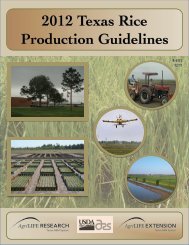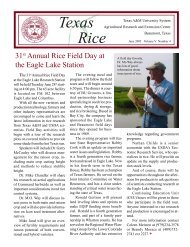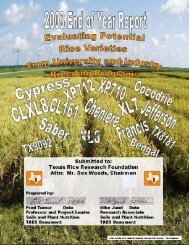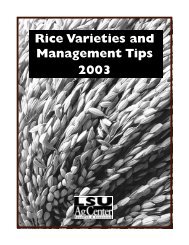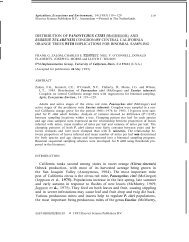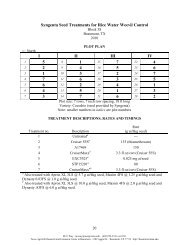2007 - Texas A&M AgriLIFE Research Center at Beaumont - Texas ...
2007 - Texas A&M AgriLIFE Research Center at Beaumont - Texas ...
2007 - Texas A&M AgriLIFE Research Center at Beaumont - Texas ...
You also want an ePaper? Increase the reach of your titles
YUMPU automatically turns print PDFs into web optimized ePapers that Google loves.
tional three-way becomes a five-way split of nitrogen.)<br />
PD applic<strong>at</strong>ion<br />
The PD applic<strong>at</strong>ion is made when 30 percent of the<br />
main stems have 2 mm or longer panicles. During this<br />
growth stage, this applic<strong>at</strong>ion is efficiently used (taken up<br />
within 3 days) by plants because the roots cover the flooded<br />
soil surface. If the rice plants appear nitrogendeficient,<br />
apply nitrogen before the PD stage.<br />
The chlorophyll meter is very useful for determining<br />
the need for PD nitrogen. If fields are very uniform in stand<br />
emergence (emergence within 2 days), applic<strong>at</strong>ions earlier<br />
than PD might be warranted.<br />
Chlorophyll meter use<br />
Because the green color of rice plants as detected by<br />
the human eye varies with cloudiness and the time of day,<br />
it is sometimes difficult to tell if nitrogen topdressing will<br />
be economical. Minolta’s model 502 chlorophyll meter<br />
provides a quick and unbiased estim<strong>at</strong>e of the need for additional<br />
nitrogen during PD and 2 weeks before PD.<br />
For example, research d<strong>at</strong>a (Fig. 1) show th<strong>at</strong>, for Lemont<br />
plants with chlorophyll readings of 40 or more, topdressing<br />
will not increase yields enough to justify the cost.<br />
The procedure for using a Minolta model 502 chlorophyll<br />
meter to determine the average chlorophyll reading<br />
in a rice field is to walk into represent<strong>at</strong>ive areas of the rice<br />
field and insert the edge of a most recently m<strong>at</strong>ured leaf, <strong>at</strong><br />
a point three-fourths of the way up the leaf, into the measuring<br />
head of the meter. When the measuring head is clamped<br />
on the leaf, the meter will provide an instant three-digit<br />
chlorophyll value.<br />
The meter will store and average up to 30 readings. Fields<br />
having chlorophyll readings above the critical levels given<br />
above are unlikely to benefit from nitrogen topdressings.<br />
Fields having lower chlorophyll values will benefit from<br />
topdressing nitrogen (Fig. 1).<br />
Although plant density can influence chlorophyll readings<br />
in rice fields, plant density usually must be less than 10 to 12<br />
plants per square foot before affecting the chlorophyll value.<br />
Another factor influencing the chlorophyll readings of<br />
rice leaves is th<strong>at</strong> the leaf midrib frequently does not divide<br />
the leaf down the center. The narrow side of the leaf tends<br />
to read one or two chlorophyll values higher than the wide<br />
side. Therefore, to reduce vari<strong>at</strong>ion in chlorophyll readings<br />
within a field, take readings only from leaves having centered<br />
midribs, or take an equal number of readings on each side of<br />
the midrib.<br />
Other factors th<strong>at</strong> influence chlorophyll readings include<br />
rice cultivar, the position of the leaf on plant and the loc<strong>at</strong>ion<br />
on the leaf where the reading is taken. Keep in mind also th<strong>at</strong><br />
chlorophyll readings may be influenced by cool we<strong>at</strong>her as<br />
well as deficiencies of phosphorus, zinc and iron.<br />
Table 9. Critical chlorophyll levels above which commonly provide<br />
no yield benefits to additional nitrogen fertilizer.<br />
Variety<br />
Chlorophyll reading<br />
Francis and Jefferson 41–42<br />
Dixiebelle, Presidio, Priscilla<br />
and Sabine<br />
Banks, Cheniere, CL131 and 161,<br />
Cocodrie, Cybonnet and Saber<br />
39–40<br />
38–39<br />
Cypress, Spring and Trenasse 37–38<br />
Yield increase due to topdress N<br />
lb/acre<br />
Figure 1. Rel<strong>at</strong>ionship between yield increase and chlorophyll readings.<br />
Chlorophyll readings<br />
–––––––––––––––––––––––––––––––––––––––––––––––––––––––––––––––––––––––––––––––––––– 19



